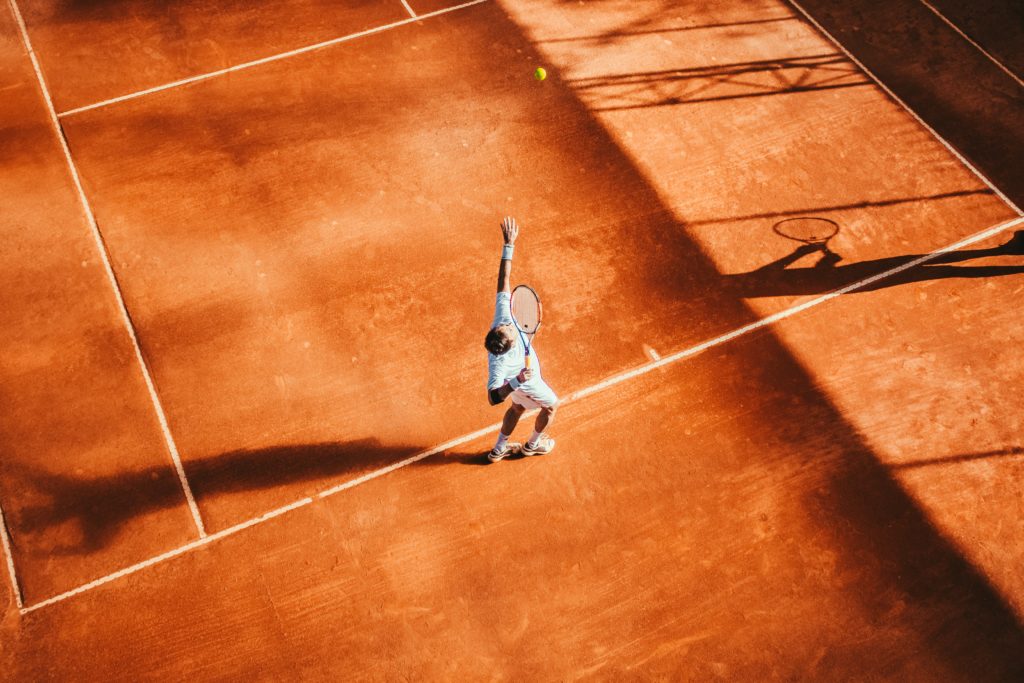
Prevention of Shoulder Injuries In Tennis by Stretching: Part 2 of 2
Last week we discussed the importance of strengthening to prevent shoulder injuries in tennis. This week we will focus on stretching the shoulder for injury prevention. As with the exercises for strength, it may be better to do nothing at all than to do so improperly. For example, the shoulder must be adequately warmed up and in the proper position and alignment to fully benefit from stretching. New research is demonstrating that proper stretching to promote good posture may help or even prevent shoulder problems.
Part of the rotator cuff, a group of muscles that stabilize the shoulder, passes between the arm bone (humerus) and a bone in the back (scapula). Due to the nature of the overhead tennis stoke or overuse from constant hitting, the rotator cuff can be repetitively pinched between the two bones. This produces a painful inflammatory condition known as rotator cuff tendonitis of the shoulder.
If the shoulder blade is tipped downwards, such as the position the shoulder assumes when slouching, it will place the shoulder in a position which pinches part of the rotator cuff. Stretching, strengthening or hitting a ball in this position will ultimately lead to problems. Add excessive training and practicing to the mix and this overuse may cause the muscles and tendons of the rotator cuff to become inflamed and swell. The swelling of the muscles and tendons will make the shoulder more prone to impingement.
A tight neck, chest and muscles in the front of the shoulder may cause a tennis player to assume a hunched over posture. This poor posture decreases the distance between the humerus and scapula making the shoulder more prone to impingement. Good posture with head and shoulders back increases the distance between the humerus and scapula. Therefore, proper stretching and good posture is important for prevention of shoulder pain because it decreases the impingement.
STRETCHING:
Warm Up: Never stretch a cold muscle because the muscle can tear instead of stretch. To warm up the muscle one can run or jog for 5 minutes, place a heating pad on the area to be stretched, slowly move the arms in the direction that imitates various tennis strokes at 25-50% speed (dynamic stretching) while never moving far enough to cause discomfort. After practice, one can perform stretches that are more aggressive and held for 5-10 seconds with slight discomfort to improve flexibility. Aggressive stretching before competition may weaken the muscle and effect performance.
The Nicholas Institute of Sports Medicine and Athletic Trauma suggests the following stretches to be performed actively (dynamic) without discomfort to 90% range of motion before competition and passively and hold to 100% end range of motion (static) with slight discomfort after practice.
Photo 1 - Triceps Stretch: Begin by raising your arm directly over your head. Bend your elbow and try to reach the shoulder blade on the same side of you body. Use your opposite arm to push your elbow back.
Photo 2– Corner Stretch to the Pectoralis Major: Begin by facing a corner and placing your forearms on the wall at a 90 degree angle. Step forward with one foot to feel the stretch.
Photo 3- Infraspinatus Stretch: Extend your arm out directly in front of you and bend your elbow across your body. With your other hand gently pull your elbow across your body.
Photo 4- Latissimus Dorsi Stretch: Raise both arms overhead and place palms together interlocking fingers. At shoulders, lift arms upwards with fingers remaining intertwined.
Head Over Shoulders: Pull your chin down and backwards as if trying to make a double chin.
Shoulder Blade Pinch: Pinch shoulder blades together
Standing Extension: Stand and lean backwards - extend lower back.
Contributor: Gary E. Mattingly, PT, PhD: Professor Emeritus, University of Scranton, Dept. of Physical Therapy
Models: Katherine Weaver, SPT
Keep in mind that avoiding bad posture in your day to day activities can help keep your shoulder and back healthy, so remember “Sit up straight!”
Visit your doctor regularly and listen to your body.
NEXT MONDAY – Read Dr. Paul J. Mackarey “Health & Exercise Forum” in the Scranton Times-Tribune.
This article is not intended as a substitute for medical treatment. If you have questions related to your medical condition, please contact your family physician. For further inquires related to this topic email: drpmackarey@msn.com
Paul J. Mackarey PT, DHSc, OCS is a Doctor in Health Sciences specializing in orthopaedic and sports physical therapy. Dr. Mackarey is in private practice and is an associate professor of clinical medicine at Geisinger Commonwealth School of Medicine.